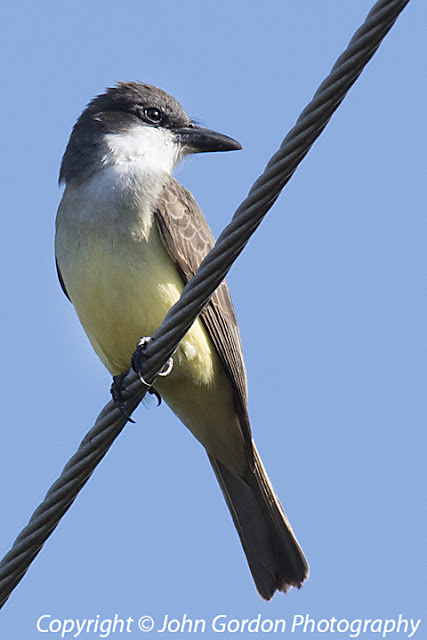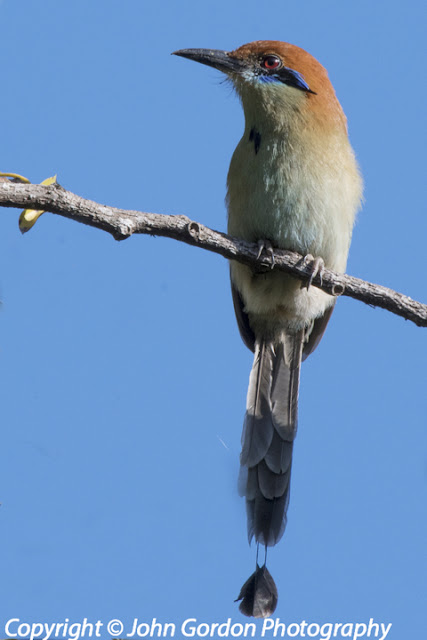Cerros de Guaybitos. Punta Raza and Chula Vista.
Jan 28 2017 Cerros de Guayabitos 6.30 a.m.-11am
Sadly our little sojourn in Mexico was coming to an end.
There were just a few mornings left of the trip so I decided to take full advantage by rising early and making my way to a hillside trail behind our hotel.
There were just a few mornings left of the trip so I decided to take full advantage by rising early and making my way to a hillside trail behind our hotel.
I took this picture from the lookout before sunrise.
One bird I had been photographing without much success was the blue bunting. They can be very sculky and difficult to photograph. When one landed about twenty feet in from of me I finally I had my shot.
 |
| Blue Bunting (endemic) |
*****
Jan 29 2017 Punta Raza 7.38a.m.-11.38
Next morning bright and early I met Canadian 'Snowbirds' and part-time Los Ayala residents Ed, Kevin and Myrna. The trail to Punta Raza is accessed through a hole in the fence. It's probably best to go with someone who knows the trail system before going on your own as it would be easy to get lost. We walked uphill through a jungle of mixed hardwoods, thorn trees, palm, coconut and banana trees. A few orchids and tillandsia (air plants) were blooming high up on overhanging boughs. I was puzzled by all the holes in the forest floor, even though we were nowhere near the ocean turns out they were the lair of land crabs.
The trails have been kept open by a number of Canadians, including one elderly gentleman from Saskatoon who spends part of his four months holiday escaping the bitter prairie weather and expending the trail system for others to enjoy.
The trails have been kept open by a number of Canadians, including one elderly gentleman from Saskatoon who spends part of his four months holiday escaping the bitter prairie weather and expending the trail system for others to enjoy.
Exiting the forest we began to see some good birds including northern mockingbird, rufous-bellied chachalacha, four species of flycatcher and a rose-throated becard.
According to Ed who knows the area well the farmland we were passing through was under several feet of water this time last year.
 |
| Thick-billed Kingbird |
 |
| Tropical parula. |
 |
| Brown-crested flycatcher. |
Jan 29, 2017 7:38 AM - 10:38 AM
Protocol: Traveling
7.6 kilometer(s)
60 species
Gadwall 2
Blue-winged Teal 22
Rufous-bellied Chachalaca 3
Blue-footed Booby 5
Neotropic Cormorant 3
Brown Pelican 10
Great Blue Heron 2
Snowy Egret 2
Little Blue Heron 1
Tricolored Heron 3
Black Vulture 19
Turkey Vulture 10
Osprey 1
Great Black Hawk 1
Gray Hawk 1
Zone-tailed Hawk 1
Black-necked Stilt 1
Killdeer 3
Spotted Sandpiper 2
Inca Dove 3
Common Ground-Dove 2
Ruddy Ground-Dove 2
White-winged Dove 4
Groove-billed Ani 12
Squirrel Cuckoo 2
Cinnamon Hummingbird 1
Belted Kingfisher 1
Green Kingfisher 2
Golden-cheeked Woodpecker 8
Mexican Parrotlet 5
Ivory-billed Woodcreeper 1
Pacific-slope Flycatcher 6
Dusky-capped Flycatcher 1
Ash-throated Flycatcher 1
Brown-crested Flycatcher 2
Great Kiskadee 8
Social Flycatcher 4
Tropical Kingbird 12
Thick-billed Kingbird 3
Masked Tityra 2
Rose-throated Becard 3
Plumbeous Vireo 1
Warbling Vireo 6
Northern Rough-winged Swallow 22
Happy Wren 1
Sinaloa Wren 3
Blue-gray Gnatcatcher 12
Rufous-backed Robin 4
Northern Mockingbird 1
Orange-crowned Warbler 6
Nashville Warbler 7
Common Yellowthroat 2
Tropical Parula 4
Yellow Warbler 2
Black-throated Gray Warbler 4
Wilson's Warbler 3
Yellow-breasted Chat 1
Stripe-headed Sparrow 3
Streak-backed Oriole 3
Yellow-winged Cacique 2
******
Jan 30 2017 Chula Vista and area "Last Day in Mexico" 7a.m-12 noon
Today would be my second visit to Chula Vista and the last day of birding. Would there be any surprises? We, that is Monica Nugent, Ed Jordan, Kevin and Myrna Field, Gareth Pugh and myself all squeezed into a taxi and left for our destination about ten kilometres south of Rincon de Guayabitos. Chula Vista is popular with local bird guides for obvious reasons. Last time we had 102 species in three hours.
 |
| Anhinga. |
Our first stop was, a large the pond quickly produced northern jacana, anhinga, stork, least grebe and more listed at the end of this blog.
 |
| Sinaloa Wren |
 |
| Dragonfly |
Passing through a plantation blue-black grassquit, vermillion flycatcher, Sinoloa wren, northern mockingbird, white-winged dove were added to our list.
Our walk took us through a long stretch of road bordered on both sides by corn and pineapple fields. Small waterways held egrets, white ibis and more storks.
 |
| Wood stork. |
 |
| Laughing falcon. |
We heard the laughing falcon from a kilometre off before it flew in front of us and landed in a nearby tree.
 |
| Snail kite. |
A snail kite came out of nowhere its gaze downwards, looking for its main food, the apple snail. For this reason, it is considered a molluscivore. (Wikipedia)
 |
| Apple snail. |
 |
| Roseate spoonbill. |
Our walk was as eventful as the last time with the snail kite, white kite and fulvous whistling-duck being lifers.
Chula Vista Pond, Nayarit, MX
Jan 31, 2017 7:08 AM - 9:48 AM
Protocol: Traveling
4.3 kilometer(s)
69 species
Black-bellied Whistling-Duck 22
Fulvous Whistling-Duck 8
Fulvous Whistling-Duck 8
Least Grebe 1
Wood Stork 1
Magnificent Frigatebird 12
Neotropic Cormorant 11
Double-crested Cormorant 1
Anhinga 5
Great Blue Heron 1
Great Egret 2
Little Blue Heron 1
Cattle Egret 3
Green Heron 1
Turkey Vulture 10
White-tailed Kite 1
Snail Kite 2
Harris's Hawk 1
Gray Hawk 2
Purple Gallinule 1
Killdeer 4
Northern Jacana 5
Wilson's Snipe 5
Eurasian Collared-Dove 3
Inca Dove 2
Common Ground-Dove 2
Ruddy Ground-Dove 7
White-tipped Dove 1
White-winged Dove 2
Groove-billed Ani 4
Cinnamon Hummingbird 1
Green Kingfisher 1
Golden-cheeked Woodpecker 5
Crested Caracara 2
Laughing Falcon 1
American Kestrel 2
Merlin 1
Mexican Parrotlet 7
Ivory-billed Woodcreeper 1
White-throated Flycatcher 1
Vermilion Flycatcher 4
Great Kiskadee 5
Social Flycatcher 3
Tropical Kingbird 7
Thick-billed Kingbird 2
Masked Tityra 2
Northern Rough-winged Swallow 19
Barn Swallow 4
Sinaloa Wren 1
Blue-gray Gnatcatcher 6
Rufous-backed Robin 2
Northern Mockingbird 1
Orange-crowned Warbler 3
Common Yellowthroat 8
Yellow Warbler 2
Yellow-rumped Warbler 2
Wilson's Warbler 2
Yellow-breasted Chat 2
Blue-black Grassquit 5
White-collared Seedeater 3
Lark Sparrow 12
Blue Bunting 2
Blue Grosbeak 2
Varied Bunting 1
Painted Bunting 1
Great-tailed Grackle 23
Bronzed Cowbird 7
Orchard Oriole 4
Hooded Oriole 2
Streak-backed Oriole 4
Finally the holiday was over. Any expectations or lack of beforehand were met and surpassed. Apart from the three days in San Blas with guide Francisco Garcia of Safaris San Blas (see Facebook) all the birding was done in and around Rincon de Guyabitos. A huge thanks must go to Ed Jordan. We actually met by chance in La Penita, both of us with bins around our necks, a most fortuitous meeting for which I owe Ed a huge thanks.
This trip, my second to Mexico produced 224 species with 137 lifers. Most of all I had the time of my life, met some really good birders, their generosity made for an unforgettable experience.
"It's never too late to start birding in Mexico"
John Gordon
Langley/Cloverdale
BC Canada































